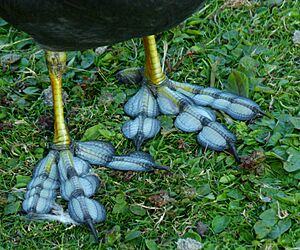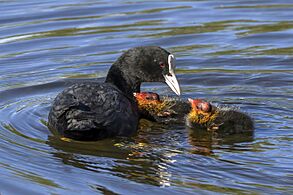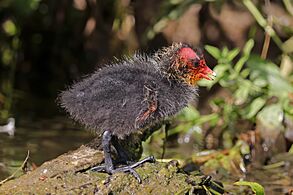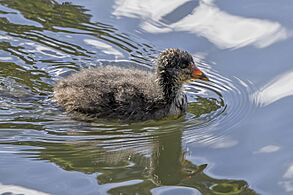Eurasian coot facts for kids
Quick facts for kids Eurasian coot |
|
|---|---|
 |
|
| Conservation status | |
| Scientific classification | |
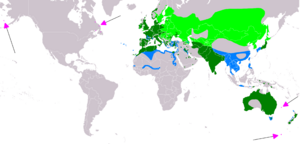 |
|
| Range Breeding Resident Non-breeding Vagrant (seasonality uncertain) | |
| Synonyms | |
|
The Eurasian coot (Fulica atra), also known as the common coot or Australian coot, is a cool water bird. It belongs to the Rallidae family, which includes rails and crakes. You can find these birds in Europe, Asia, Australia, New Zealand, and parts of North Africa. They are easy to spot with their dark, slaty-black bodies, shiny black heads, and bright white bills with a white patch on their forehead. Both male and female coots look very similar. Many different kinds of coots live around the world, especially in South America.
Contents
What is a Eurasian Coot?
The Eurasian coot was officially named by a Swedish scientist named Carl Linnaeus in 1758. He gave it the scientific name Fulica atra. In Latin, Fulica means "coot," and atra means "black." This name perfectly describes this dark-colored bird!
There are four main types, or subspecies, of the Eurasian coot:
- F. a. atra: Found from Europe and North Africa all the way to Japan, India, Southeast Asia, the Philippines, and Borneo.
- F. a. lugubris: Lives in Java, Bali, and northwest New Guinea.
- F. a. novaeguineae: Found in central New Guinea.
- F. a. australis: Lives in Australia and New Zealand.
How to Spot a Eurasian Coot
Eurasian coots are about 36 to 38 centimeters (about 14-15 inches) long. Their wings can spread out to 70 to 80 centimeters (about 27-31 inches). Males usually weigh around 890 grams (about 2 pounds), and females weigh about 750 grams (about 1.6 pounds).
They are mostly black, but their most noticeable features are their white bill and the white patch on their forehead. This white patch is called a frontal shield. It's where the old saying "as bald as a coot" comes from, which people have used since the 1400s!
Coots are great swimmers. They have long, strong toes with special partial webbing. This webbing helps them paddle in the water. Male and female coots look very much alike.
Young coots look a bit different from adults. They are lighter in color and have a whitish chest. They also don't have the white facial shield yet. Their adult black feathers grow in when they are about 3 to 4 months old. The white shield fully develops when they are about one year old.
Eurasian coots are quite noisy birds. They make many different sounds, like crackling, explosive, or trumpeting calls. You might even hear them calling at night!
Where Do Coots Live?
Coots breed in many parts of the Old World, which includes Europe, Asia, and Africa. They like freshwater lakes and ponds. Just like their relatives, the common moorhens, coots have learned to live well in cities. You can often find them in parks and gardens that have water. They live and breed in Europe, Asia, Australia, and Africa. Recently, they have also started living in New Zealand.
In warmer areas, coots stay all year round. But in colder parts of Asia, they fly south and west for the winter when the water freezes. Sometimes, a coot might even wander off course and be seen in North America!
Coot Behavior and Lifestyle
The Eurasian coot is not as shy as most birds in the rail family. You can often see them swimming in open water or walking on grassy areas near the water. They are quite aggressive birds, especially when they are breeding. Both parents work together to protect their territory.
When it's not breeding season, coots might gather in large groups. This could be a way for them to protect themselves from predators.
Coots don't like to fly much. When they do take off, they run across the water surface, making a lot of splashes. They do the same thing, without actually flying, when they need to move quickly for a short distance during fights over territory or to escape danger on land. Even though their flight looks weak, they can travel surprisingly long distances when they migrate, usually at night.
When swimming, a coot bobs its head. It also makes short dives to find food, sometimes jumping a little before diving.
If a coot is fighting with another waterbird, especially another coot, it will charge at its opponent. It then strikes them with its long legs.
Reproduction and Life Cycle
Coots build a large nest, usually made of plant stems and leaves. The nest can float on the water or be built in shallow water on a low tree stump or log. It's a neat, big bowl. The nest is often hidden in plants, but sometimes it can be in the open. Both male and female coots help build the nest. The male usually gathers most of the materials, and the female puts them together.
The female lays one egg each day. A group of eggs, called a clutch, usually has between six and ten eggs. They are smooth, slightly shiny, and buff-colored, with black or dark brown speckles. On average, they are about 53 by 36 millimeters (about 2 by 1.4 inches) and weigh about 38 grams (about 1.3 ounces).
Both parents take turns sitting on the eggs to keep them warm. They start incubating after the second egg is laid. The chicks hatch one by one after 21 to 24 days.
Coot chicks are born with black downy feathers. They have yellow hair-like tips on their bodies. On the sides of their heads, neck, and throat, these hair-like tips are longer and orange-red. Between their eyes and on their faces, the tips are red. Their forehead shield is bright red, and their bill is red with a white tip.
The mother coot keeps the chicks warm for the first three or four days. During this time, the father coot brings food to them. The male also builds one or more platforms where the family can rest and where the chicks can be kept warm.
When the chicks leave the nest, sometimes the parents split them up, with each parent taking care of a different group. The young coots can find their own food when they are about 30 days old. They learn to fly when they are 55 to 60 days old.
Eurasian coots usually have only one group of chicks each year. However, in some places like Britain, they might try to have a second group. They start breeding when they are one to two years old.
Sadly, many chicks don't survive, mostly because they don't get enough food, rather than from predators. Most chicks die in their first 10 days after hatching, when they rely most on their parents for food. Coots can be very tough on their own young, especially if there isn't enough food. They might peck chicks that are asking for food. If a chick keeps asking, the parent might peck it so hard that the chick dies.
Sometimes, coots will lay their eggs in the nests of other coots. They do this if their environment makes it hard for them to breed, or to have more chances to reproduce.
-
Adult with chicks, Trujillo, Spain
What Do Coots Eat?
The coot is an omnivore, which means it eats both plants and animals. It will eat different small live creatures, including the eggs of other water birds. It also eats algae, other plants, seeds, and fruit.
Coots have many ways of finding food. They might graze on land or in the water. In the water, they can tip their bodies upside down, like a mallard duck, or dive underwater to search for food.
Status
The Eurasian coot is a bird that is part of an important agreement called the Agreement on the Conservation of African-Eurasian Migratory Waterbirds (AEWA). This agreement helps protect birds that migrate across Africa and Eurasia.




